Aromatherapy oils are volatile, (easily evaporated) substances that occur naturally in a variety of plants growing the world over. Each plant essence is extracted from a single botanical source through a number of possible methods, the most common and generally favoured being that of steam distillation.
There are a number of methods by which the volatile components of aromatic plants may be extracted for commercial purposes. However, such a volatile product cannot be considered a true essential oil unless it has been produced either through distillation or cold expression.
Steam Distillation Extraction Of Essential Oils
The process of steam distillation begins when the distiller inserts the chosen plant material or “charge”, into a special chamber. Often at considerable pressure, steam is then forced into the chamber. As it passes through the plant material, the steam ruptures the plants oil bearing sacs and cavities, and liberates its essence, which consequently evaporates into steam. The steam and vaporised essential oil then pass out of the chamber and through a coiled tube surrounded by cold water.
Here, they condense into water and liquid essential oil, and flow into a collecting vase. The oil is unable to mix with water and so forms a layer above it, making it easy to separate. Small quantities of odorous principals also remain in the water, forming a fragrant water, or hydrolat. The hydrolat is often used to form the new distillation steam, and becomes more concentrated in the process.
Floral waters such as rose and chamomile have been important for skin care and fragrance ever since distillation was discovered in the 13th century.
Cold Expression Extraction Of Aromatherapy Oils
Cold expression is a process used for the extraction of aromatherapy oils from the rind of citrus fruits. The outer layer of the peel is ruptured through mechanical means and the essence, or zest, pressed out. Cold-pressed grades of orange oil, bergamot oil, mandarin oil, grapefruit oil, lemon, and lime oils are obtained in this way.
Traditional Enfleurage Extraction Of Aromatherapy Essential Oils
The traditional process of enfleurage is still occasionally used to extract the aromatic components of delicate flowers such as jasmine. A layer of fresh flowers is placed on a thin layer of odourless animal fat, called the chassis. The fat gradually becomes saturated with the aromatic constituents of the flower, and is then trated with alcohol to produce an absolute ex pomade. This process is very expensive and not widely used.

